Edward Lin
Code-Switching Text Generation and Injection in Mandarin-English ASR
Mar 20, 2023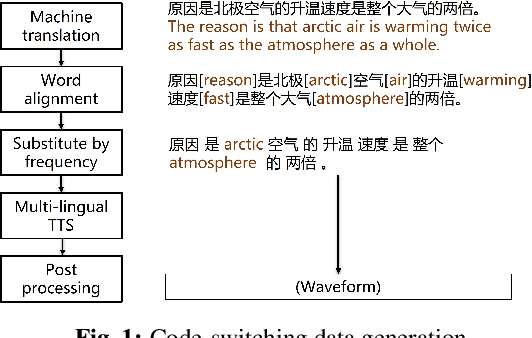
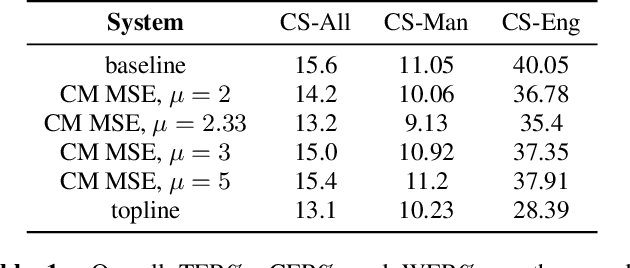
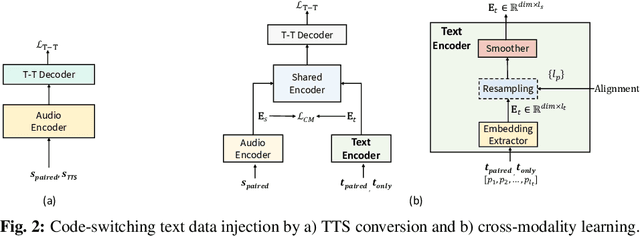

Abstract:Code-switching speech refers to a means of expression by mixing two or more languages within a single utterance. Automatic Speech Recognition (ASR) with End-to-End (E2E) modeling for such speech can be a challenging task due to the lack of data. In this study, we investigate text generation and injection for improving the performance of an industry commonly-used streaming model, Transformer-Transducer (T-T), in Mandarin-English code-switching speech recognition. We first propose a strategy to generate code-switching text data and then investigate injecting generated text into T-T model explicitly by Text-To-Speech (TTS) conversion or implicitly by tying speech and text latent spaces. Experimental results on the T-T model trained with a dataset containing 1,800 hours of real Mandarin-English code-switched speech show that our approaches to inject generated code-switching text significantly boost the performance of T-T models, i.e., 16% relative Token-based Error Rate (TER) reduction averaged on three evaluation sets, and the approach of tying speech and text latent spaces is superior to that of TTS conversion on the evaluation set which contains more homogeneous data with the training set.
FoundationTTS: Text-to-Speech for ASR Customization with Generative Language Model
Mar 08, 2023Abstract:Neural text-to-speech (TTS) generally consists of cascaded architecture with separately optimized acoustic model and vocoder, or end-to-end architecture with continuous mel-spectrograms or self-extracted speech frames as the intermediate representations to bridge acoustic model and vocoder, which suffers from two limitations: 1) the continuous acoustic frames are hard to predict with phoneme only, and acoustic information like duration or pitch is also needed to solve the one-to-many problem, which is not easy to scale on large scale and noise datasets; 2) to achieve diverse speech output based on continuous speech features, complex VAE or flow-based models are usually required. In this paper, we propose FoundationTTS, a new speech synthesis system with a neural audio codec for discrete speech token extraction and waveform reconstruction and a large language model for discrete token generation from linguistic (phoneme) tokens. Specifically, 1) we propose a hierarchical codec network based on vector-quantized auto-encoders with adversarial training (VQ-GAN), which first extracts continuous frame-level speech representations with fine-grained codec, and extracts a discrete token from each continuous speech frame with coarse-grained codec; 2) we jointly optimize speech token, linguistic tokens, speaker token together with a large language model and predict the discrete speech tokens autoregressively. Experiments show that FoundationTTS achieves a MOS gain of +0.14 compared to the baseline system. In ASR customization tasks, our method achieves 7.09\% and 10.35\% WERR respectively over two strong customized ASR baselines.
Building High-accuracy Multilingual ASR with Gated Language Experts and Curriculum Training
Mar 01, 2023



Abstract:We propose gated language experts to improve multilingual transformer transducer models without any language identification (LID) input from users during inference. We define gating mechanism and LID loss to let transformer encoders learn language-dependent information, construct the multilingual transformer block with gated transformer experts and shared transformer layers for compact models, and apply linear experts on joint network output to better regularize speech acoustic and token label joint information. Furthermore, a curriculum training scheme is proposed to let LID guide the gated language experts for better serving their corresponding languages. Evaluated on the English and Spanish bilingual task, our methods achieve average 12.5% and 7.3% relative word error reductions over the baseline bilingual model and monolingual models, respectively, obtaining similar results to the upper bound model trained and inferred with oracle LID. We further explore our method on trilingual, quadrilingual, and pentalingual models, and observe similar advantages as in the bilingual models, which demonstrates the easy extension to more languages.
SoftCorrect: Error Correction with Soft Detection for Automatic Speech Recognition
Dec 02, 2022



Abstract:Error correction in automatic speech recognition (ASR) aims to correct those incorrect words in sentences generated by ASR models. Since recent ASR models usually have low word error rate (WER), to avoid affecting originally correct tokens, error correction models should only modify incorrect words, and therefore detecting incorrect words is important for error correction. Previous works on error correction either implicitly detect error words through target-source attention or CTC (connectionist temporal classification) loss, or explicitly locate specific deletion/substitution/insertion errors. However, implicit error detection does not provide clear signal about which tokens are incorrect and explicit error detection suffers from low detection accuracy. In this paper, we propose SoftCorrect with a soft error detection mechanism to avoid the limitations of both explicit and implicit error detection. Specifically, we first detect whether a token is correct or not through a probability produced by a dedicatedly designed language model, and then design a constrained CTC loss that only duplicates the detected incorrect tokens to let the decoder focus on the correction of error tokens. Compared with implicit error detection with CTC loss, SoftCorrect provides explicit signal about which words are incorrect and thus does not need to duplicate every token but only incorrect tokens; compared with explicit error detection, SoftCorrect does not detect specific deletion/substitution/insertion errors but just leaves it to CTC loss. Experiments on AISHELL-1 and Aidatatang datasets show that SoftCorrect achieves 26.1% and 9.4% CER reduction respectively, outperforming previous works by a large margin, while still enjoying fast speed of parallel generation.
Mask the Correct Tokens: An Embarrassingly Simple Approach for Error Correction
Nov 23, 2022Abstract:Text error correction aims to correct the errors in text sequences such as those typed by humans or generated by speech recognition models. Previous error correction methods usually take the source (incorrect) sentence as encoder input and generate the target (correct) sentence through the decoder. Since the error rate of the incorrect sentence is usually low (e.g., 10\%), the correction model can only learn to correct on limited error tokens but trivially copy on most tokens (correct tokens), which harms the effective training of error correction. In this paper, we argue that the correct tokens should be better utilized to facilitate effective training and then propose a simple yet effective masking strategy to achieve this goal. Specifically, we randomly mask out a part of the correct tokens in the source sentence and let the model learn to not only correct the original error tokens but also predict the masked tokens based on their context information. Our method enjoys several advantages: 1) it alleviates trivial copy; 2) it leverages effective training signals from correct tokens; 3) it is a plug-and-play module and can be applied to different models and tasks. Experiments on spelling error correction and speech recognition error correction on Mandarin datasets and grammar error correction on English datasets with both autoregressive and non-autoregressive generation models show that our method improves the correction accuracy consistently.
FastCorrect 2: Fast Error Correction on Multiple Candidates for Automatic Speech Recognition
Oct 18, 2021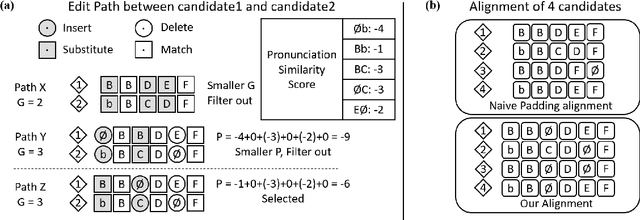
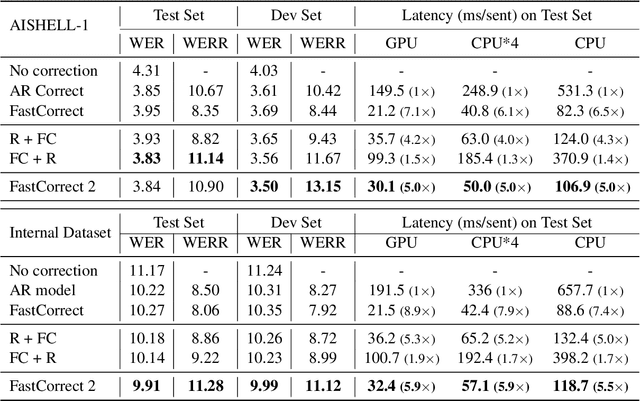
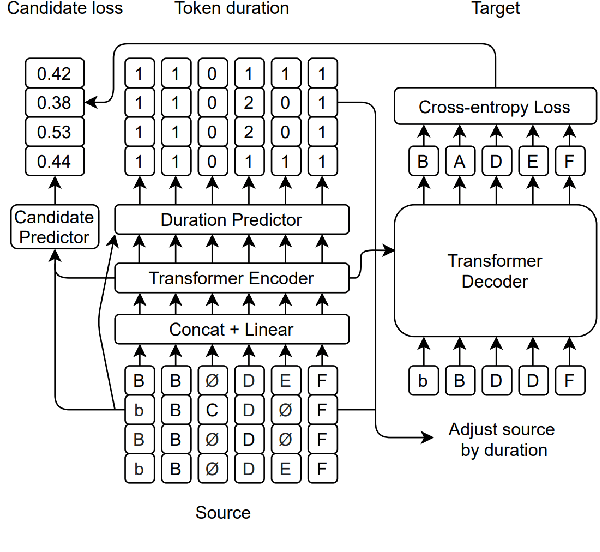
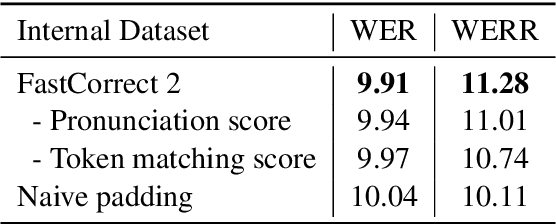
Abstract:Error correction is widely used in automatic speech recognition (ASR) to post-process the generated sentence, and can further reduce the word error rate (WER). Although multiple candidates are generated by an ASR system through beam search, current error correction approaches can only correct one sentence at a time, failing to leverage the voting effect from multiple candidates to better detect and correct error tokens. In this work, we propose FastCorrect 2, an error correction model that takes multiple ASR candidates as input for better correction accuracy. FastCorrect 2 adopts non-autoregressive generation for fast inference, which consists of an encoder that processes multiple source sentences and a decoder that generates the target sentence in parallel from the adjusted source sentence, where the adjustment is based on the predicted duration of each source token. However, there are some issues when handling multiple source sentences. First, it is non-trivial to leverage the voting effect from multiple source sentences since they usually vary in length. Thus, we propose a novel alignment algorithm to maximize the degree of token alignment among multiple sentences in terms of token and pronunciation similarity. Second, the decoder can only take one adjusted source sentence as input, while there are multiple source sentences. Thus, we develop a candidate predictor to detect the most suitable candidate for the decoder. Experiments on our inhouse dataset and AISHELL-1 show that FastCorrect 2 can further reduce the WER over the previous correction model with single candidate by 3.2% and 2.6%, demonstrating the effectiveness of leveraging multiple candidates in ASR error correction. FastCorrect 2 achieves better performance than the cascaded re-scoring and correction pipeline and can serve as a unified post-processing module for ASR.
 Add to Chrome
Add to Chrome Add to Firefox
Add to Firefox Add to Edge
Add to Edge